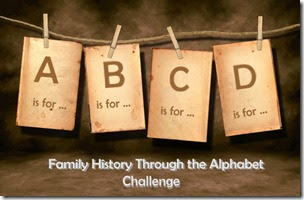
For 26 weeks I will take you on a family history journey through the alphabet, one letter at a time. I have decided that each post will be educational in nature, focusing on topics related to resources, methodology, tools, etc. Although the challenge is complete, there are still some people who are finishing up and Alona, the host, is encouraging others to participate anyway. Additional information on the challenge, can be found at Take the ‘Family History Through the Alphabet’ Challenge.
 Diigo is a social bookmarking tool with many additional features useful to researchers. I use Diigo as the application of choice for maintaining my genealogy resource toolkit. I have collected a variety of links to resources related to genealogy research, such as online record collections; out-of-copyright books that have been digitized; general information about records, repositories, and research methodology; specific places I’m researching; genealogical, historical, and lineage societies; special topics (military, women, cemetery, etc.); and much more. Diigo keeps track of the things I’ve found, and more importantly, helps me find them later when I need them, since I can organize everything into lists and tag each item with keywords.
Diigo is a social bookmarking tool with many additional features useful to researchers. I use Diigo as the application of choice for maintaining my genealogy resource toolkit. I have collected a variety of links to resources related to genealogy research, such as online record collections; out-of-copyright books that have been digitized; general information about records, repositories, and research methodology; specific places I’m researching; genealogical, historical, and lineage societies; special topics (military, women, cemetery, etc.); and much more. Diigo keeps track of the things I’ve found, and more importantly, helps me find them later when I need them, since I can organize everything into lists and tag each item with keywords.
But beyond saving my bookmarks, which I can access from anywhere, Diigo offers several research tools, including highlighting and annotating. Both tools are extremely helpful to me as a researcher.
I have been asked by several people how I use Diigo, so I have created a guide, which is available in PDF format through Scribd (and is embedded below). I hope you take some time to review this guide and that it gives you some ideas for creating your own genealogy resource toolbox.
Build Your Genealogy Resource Toolbox With Diigo
In addition to my guide, the Diigo team has created some helpful video tutorials. Keep in mind that some features may only be available for those with a Premium account (some can be used with a free account, but may be limited).
Here is an overview of the current version of Diigo (v5, as of this writing). This video also includes and overview of apps on mobile devices.
These videos highlight each of the three main ideas behind Diigo: research, share, and collaborate.

Delightful post from a dedicated Diigo devotee
Julie – I love this idea! I didn’t know about the Challenge which is over, but I’m going to participate now.
Love your post on Diigo, something I know nothing about so a great opportunity for me to learn. Thank you for writing about it.
Now, what will I write about for “A”?
Ada, hubs’ great grandpa’s sister who died in an insane asylum in the early 1900s?
Archiving techniques?
Oh, so many ideas! How clever of the original blogger who thought of this challenge
Thanks, Jill!
Lorine, I thought it was a clever idea as well, but I just couldn’t take part in it while it was going on. So when I saw it was over and that Alona was still encouraging people to participate, I figured, what the heck. It’s forcing me to write! I scheduled out every letter, so I know what my topic is each week and don’t have to think about it. I chose to keep all of these posts education, mainly because I had a list of things I wanted to blog about, but just never seemed to get around to, so now I have a reason to get them done. Guess I needed a little something to get me back on track…and stay on track!
Julie, firstly apologies for being behind with my reading/commenting/linking to your Alphabet posts. But going on a geneacruise does tend to put you behind with things. So I’m playing catchup now!
Anyway I love your post. I admit that I have heard of Diigo, but haven’t used it. Thankyou for your decription of it, and how you ise it.